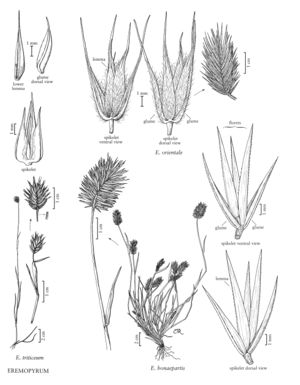Eremopyrum bonaepartis
Culms to 30 cm, smooth, mostly glabrous, puberulent below the spikes. Blades 3-5 mm wide, scabrous distally. Spikes 1.4-4.5 cm long, 1.3-2.8 cm wide, oblong, obtuse, or truncate; disarticulation at the rachis nodes. Spikelets 10-25 mm, with 3-5 florets. Glumes 4-19 mm, scabrous or hairy, 3-5-veined, 1-keeled, lateral-veins obscure, bases straight; lemmas 6-24 mm, glabrous, scabrous, or hirsute, all alike in their pubescence, apices subacute to shortly awned; palea keels prolonged into 2 toothlike appendages. 2n = 14, 28.
Distribution
N.Y.
Discussion
In the Flora region, Eremopyrum bonaepartis is known only from a few collections in Arizona. Several infraspecific taxa have been recognized in Eurasia: subsp. bonaepartis has glabrous lemmas and glumes; specimens with pilose, hirsute, or fairly scabrous lemmas and glumes have been referred to as subsp. hirsutum (Bertol.) Melderis or subsp. sublanuginosum (Drobow) Á. Löve ; and those with awned lemmas have been called subsp. turkestanicum (Gand.) Tzvelev. No attempt has been made to determine which are present in the Flora region.
Selected References
None.
Lower Taxa
"decumbent" is not a number."+timesthelengthof" is not declared as a valid unit of measurement for this property.
